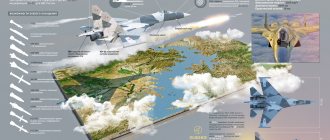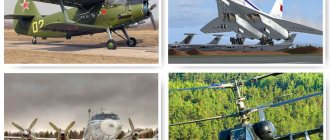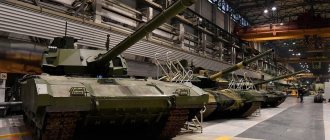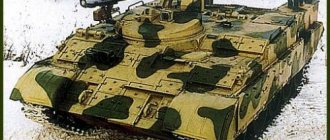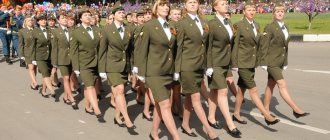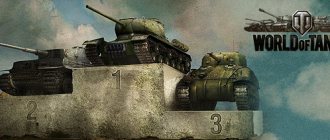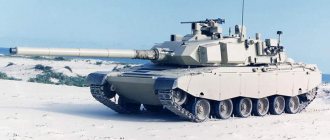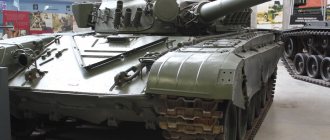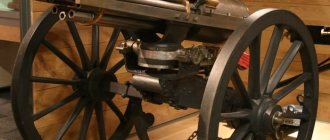Su-34 Dimensions. Engine. Weight. Story. Range of flight. Service ceiling
Su-34 is a Russian multifunctional fighter-bomber designed to carry out air strikes against enemy ground targets in operational and tactical depth in conditions of strong opposition from enemy air defense systems due to its unique combat qualities and the use of modern electronic warfare systems and destruction of enemy air targets. day and night in simple and difficult weather conditions.
Interesting Facts
One of the first pre-production copies of the Su-34 made a non-stop flight along the Moscow-Sakhalin route with several in-flight refuelings, which confirmed the possibility of performing long flights on this type of aircraft.
There is a passage between the seats to accommodate the Su-34 crew, which can be used as a place to sleep and rest. Behind the seats there is free space sufficient to accommodate full-length crew members.
In this case, instrument readings are displayed on the glazing of the canopy, which allows you to monitor them from the rear of the cabin.
All Su-34 front-line bombers have a kitchen equipped with vessels for storing water and food supplies and a microwave oven.
There is a bathroom at the rear of the cabin. The Su-34 is depicted on a souvenir silver coin with a denomination of one ruble, issued by the Bank of Russia in the series “Armed Forces of the Russian Federation”. The coin was released in a limited edition (5 thousand pieces) in 2009.
In the spring of 2016, a pair of Su-34s were used to clear ice jams on the Northern Dvina River. Air bombs weighing 250 kg were used to destroy the ice.
Su-34 bomber - video
In terms of its combat capabilities, the Su-34 belongs to the 4++ generation and allows it to carry out basic combat missions without being accompanied by cover fighters due to its high combat qualities, allowing it to conduct independently maneuverable air combat with any existing enemy fighters on equal terms.
Story
The aircraft was created as a replacement for the Su-24 front-line bomber, which was successfully used in armed conflicts in recent years. The development of the aircraft was carried out against the background of the existence of a large number of modern fourth-generation fighters of the F-15 and F-16 type among the potential enemy and, accordingly, the emerging need for the aircraft under development to be able to conduct defensive air combat with equal capabilities for aircraft of the 4+ generation.
The basis for the development of the aircraft was the experience of combat use of all types of aircraft in service with the Air Force of the USSR (Russia), as well as foreign experience in the use of aviation in local conflicts. When developing the aircraft, the designers used the “Longitudinal Triplane” aerodynamic design, which made it possible to increase the maneuverability of the aircraft compared to the conventional design; the bomb load and fuel reserves were also increased compared to the Su-27 aircraft. The flattened front section of the aircraft, nicknamed "Duckling", is equipped with a two-seat cabin, which implements methods to improve crew comfort during long flights.
Development of the aircraft began on June 19, 1986, under the code name T-10V (Su-27IB “fighter-bomber”). The basis for the development of the aircraft was taken from the design of the successful Su-27 fighter. The first flight of the T-10V-1, a prototype of the Su-34, took place on April 13, 1990. The first public display of the aircraft under the designation Su-32FN took place in the spring of 1995 in France at the international air show in Le Bourget. Then experimental aircraft were produced in the amount of 2 flightable ones and one sample for the static test stand. They were followed by pre-production aircraft in the amount of 6 flightable ones and one more sample for the static test stand. Subsequently, the sixth pre-production aircraft was modified to a production model, which is now based in the 929th GLITs Akhtubinsk.
The first flight of the Su-34 production aircraft, built under a state order for the Russian Air Force, took place on October 12, 2006 from the airfield of OAO NAPO named after V.P. Chkalov. The plane was piloted by test pilots Evgeny Rudakas and Rustem Asadullin. The state testing program took place from October 30, 2006 to September 19, 2011 in several stages simultaneously with the production of the aircraft.
The Su-34 entered service with the Russian Air Force on March 20, 2014.
Production
Serial production of the aircraft was launched at the Novosibirsk Aviation Plant on April 20, 2005. In 2008, a 5-year contract No. 319/3/1-ЕОЗ dated November 10, 2008 worth 33.6 billion rubles was signed for the supply of 32 aircraft; work began in 2009.
On March 1, 2012, a state contract was signed for the supply of 92 Su-34 front-line bombers until 2022.
Supplies
The first two production Su-34s under the first contract were received on December 18, 2006. Starting from 2015, it is planned to produce 18-20 cars per year. So far, all the capacities at the factories are loaded, but the enterprise is undergoing large-scale re-equipment. In the future, the Russian Aerospace Forces plan to receive 150-200 aircraft of this type and by 2022 completely replace the Su-24 with them.
The first two Su-34s under the second contract were transferred to the Russian Air Force in Novosibirsk on December 24, 2013, the next 18 aircraft in 2014, another 18 aircraft in 2015, and 16 aircraft in 2016. There are 38 aircraft left.
As of November 29, 2015, the Russian Aerospace Forces received 79 vehicles (11 of them in 2015). However, according to other data, by the end of 2015, the Russian Aerospace Forces received 18 aircraft, of which 2 were unscheduled, so the total number of aircraft transferred to the Russian Aerospace Forces was 83 units.
Delivery plans
The plant plans to produce 18-20 aircraft per year, starting in 2015. On August 16, 2016, the official representative of NAZ named after. V.P. Chkalova said that in the near future the Russian Air Force will receive the hundredth Su-34 front-line bomber. By 2022, the Russian Aerospace Forces plan to receive 150-200 Su-34 aircraft and completely replace the Su-24 with them.
According to the Russian Ministry of Defense, according to the plan, the aircraft plant should annually supply the Russian Aerospace Forces with 14 aircraft. However, the schedule has been exceeded by 2 vehicles annually since 2014. Thus, from 2014 to 2016, 16 Su-34s were delivered annually. The same number of aircraft will be transferred to the Aerospace Forces in 2022.
Airframe and landing gear
The airframe of the Su-34 front-line bomber has an integrated circuit layout and is built according to a longitudinal triplane design. The trapezoidal wing has a leading edge angle of 42 degrees.
An additional horizontal tail is installed in front of the wing, which can be rotated in a wide range as a whole. The power plants were located in two nacelles installed in the center section of the aircraft.
The inlet air channels were not adjustable, since the main purpose of the Su-34 was to carry out bombing and missile strikes while flying at low altitudes. The nose cone of the fuselage received an elongated shape, which made it possible to place an on-board radar with a small-sized antenna.
For takeoff and landing of the aircraft, a landing gear with a steerable nose strut is used, equipped with two parallel wheels and two main supports located on the wings.
The wing strut niches are located in the center section, directly behind the engine nacelles. When cleaning, the stand, equipped with a tandem installation of two wheels, rotates around its axis.
The landing gear design was developed taking into account the possibility of using the Su-34 aircraft from unpaved airfields.
For additional braking during landing there is a double parachute located in a container on the top of the fuselage. Before releasing the canopies, the container is pulled out of the Su-34 fuselage.
Combat use
Armed conflict in South Ossetia
For the first time, two Su-34 units were used during the war in South Ossetia in August 2008. The planes were used to cover the actions of strike aircraft, conducting electronic warfare against elements of the Georgian air defense, using the Khibiny jamming station. To suppress the electronic warfare system, the Su-34 jammed combat formations, which did not allow the Georgian air defense system to successfully tune out the interference, and also destroyed the key 36D6-M radar near the village of Shavshvebi near Gori with an anti-radar missile.
Russian military operation in Syria
During the Russian military operation in Syria, 6 Su-34 aircraft as part of the Russian Aerospace Forces Aviation Group in Syria have been used since September 30, 2015. The first strikes from a height of 5000 m were carried out on terrorist targets in the area of the populated areas of Madan-Jadid and Raqqa. As a result, the militants' command post and terrorist training infrastructure were completely destroyed.
From August 16, 2016, by agreement with the Iranian government, the Aviation Group began to use Hamadan airfield, to which Su-34 and Tu-22M3 were relocated from the Southern Military District. By agreement with the governments of Iran and Iraq, the group carries out combat missions from Hamadan airfield through Iraq to strike targets of the terrorist groups ISIS and Jabhat al-Nusra. The group's aircraft are covered by Su-30SM and Su-35S fighters from the Khmeimim airbase in Syria.
Combat use for economic needs
The planes were used in the spring of 2016 to bomb over ice jams in the Vologda region.
Fuel system
The fuel supply on board the Su-34 aircraft is located in several fuel tanks located in the fuselage, wing section and console parts of the wings. The number of tanks and their exact location differs according to data from various sources.
All tanks are interconnected by a pipeline system with transfer pumps. This allows fuel to be produced evenly during the flight, maintaining the aircraft's alignment within specified limits.
Kerosene is taken into the fuel supply equipment of engines from a special supply tank. The inner surface of all tanks is covered with a protector based on a polyurethane foam mixture.
If the tank of a Su-34 is punctured with such protection, the formation of fuel-air mixtures, which could lead to a fire on board, is prevented.
To increase the range, it is possible to install jettisonable fuel tanks on external mounts. The maximum volume of hanging tanks is up to 3000 l.
The second way to increase flight range is an in-flight refueling system.
The role of a refueling tanker can be an Il-78 type vehicle or another Su-34 aircraft equipped with a special suspended unit for refueling. Refueling can be done at night by illuminating the hose with two headlights located in the bow.
Design
Forward looking radar
The radar station of the Su-34 Sh-141 aircraft is designed to detect ground and air targets. Detection range:
- large ground targets up to 200-250 km, - typical ground targets up to 150 km, - with target type identification as “potential tanks and tracked infantry fighting vehicles” up to 75 km, - large air targets without stealth technologies such as “transport aircraft” is up to 250 km; small air targets of the fighter type are up to 90 km.
The radar supports tracking up to 10 targets (simultaneously) and firing up to 4 targets (simultaneously), and is also designed to assist the guidance of air-to-air missiles with its own radars by “target illumination” for the RVV-AE and R-27. For the R-73 close-range missile - up to 20-40 km, with an infrared seeker, the radar provides the initial coordinates of the target.
The radar has a function for flying at extremely low altitudes with automatic terrain following TFR.
Rear-view radar
The rear-view radar is located in a container between the engines and allows you to detect a Su-34 attack in the rear hemisphere with missiles, while as a countermeasure, the rear-view radar supports the firing mode of the attacking fighter by targeting a special RVV-AE air-to-air missile launched from the Su-34 itself rear hemisphere to attack an attacking fighter without wasting time on maneuvering to destroy it.
Since a rear-view radar with the ability to launch missiles into the rear hemisphere is a rather unique technology, which, according to expert opinions and published specifications, the most common (F-15, F-16) and even promising (F-22, Eurofighter Typhoon) fighters do not have -NATO bombers, many experts are debating the reality of its existence and performance.
Many experts believe that the rear-view radar is in an unfinished stage, others believe that the radar has not yet been adopted for service. Thus, a photo of the assembly of the Su-34 with the radio-transparent cover removed, under which two miniature panels are visible, was published in the open press. A similar device is visible in other photos. However, the purpose and affiliation of these devices to any aircraft systems is not indicated.
At the MAKS-2001 exhibition, fragmentary information about the Kopyo-DL rear-view radar was provided. According to the performance characteristics of the “Spear-DL” in the 2001 version, a miniature radar panel with a diameter of about 30 cm, however, ensured control of missiles in the rear hemisphere and at a distance of 6-14 km at angles of +/- 60 degrees.
Many analysts believe that the N012 radar is used as a rear-view radar, and even published a graph of its sensitivity, which was presented by NIIP. Tikhomirov to Western potential buyers at the Singapure Air Show 2008.
Outboard reconnaissance equipment
In the variant of using the Su-34 as a reconnaissance aircraft, the use of suspended equipment is provided - the suspended universal reconnaissance container (UCR) "Sych", which is designed in three versions, depending on the type of reconnaissance:
— radio engineering; — radar; — optical.
Effective reflective area
The aircraft was developed taking into account modern requirements for reducing ESR. For this purpose, composite materials were used in the production of the aircraft to reduce the level of reflection of radar waves due to radio-absorbing coatings; when designing the integrated aerodynamic design, aerodynamic ridges (ventral fins) were excluded and the geometry of the airframe was specially calculated.
According to representatives of the OKB im. P.O. Sukhoi Su-34, when flying at low altitudes, has a degree of radar signature at the level of a cruise missile.
Electronic warfare and suppression of air defense systems
To actively counter enemy radar guidance stations if detected, the Su-34 is equipped with an electronic warfare system, which the Su-34 reduces the likelihood of being hit by radar-guided systems by about 30 times. The equipment of the aircraft complex is close to that of specialized electronic warfare aircraft. The power of the electronic warfare system on the Su-34, according to Western experts, is approximately similar to the level of equipment on the EF-111A and EA-18G aircraft.
The Su-34 electronic warfare system has external radar radiation receivers and can use Khibiny electronic warfare modules (product L-175V) or L005-S Sorptsiya-S.
To fire at the radar of enemy air defense systems, the Su-34 can use Kh-58, X-15P, Kh-31P missiles at ranges of up to 120-160 km and Kh-31PD at ranges of 180-250 km.
The practical effectiveness of the electronic warfare system was tested during the military conflict in Georgia, where the Su-34 was used as an electronic warfare aircraft.
Means for guiding bombs and missiles at ground targets
To use aviation weapons, the aircraft is equipped with a sighting system that allows you to search for and hit targets using a radar system. One of the systems of the complex is the Platan optical system, which is used to target air-to-ground missiles of the Kh-29L type, KAB-500-L and KAB-1500-L guided bombs with laser seekers that require target illumination. Versions of the Kh-29T missile and KAB-500Kr bombs do not require further guidance by the Su-34 complex after receiving the initial coordinates of the target; guidance to the target then occurs through recognition by a TV camera in the seeker.
Used for destruction with conventional weapons (conventional (unguided) bombs, unguided missiles), the aircraft's sighting system provides accuracy comparable to the use of expensive high-precision weapons. This effectiveness of the use of conventional weapons was noted by NATO experts based on the experience of using the Su-34 in Syria. At the same time, NATO experts note the relatively low cost of bombing compared to the use of guided bombs (The cost of BGL-type bombs is about $100,000 per unit, their Russian analogue KAB-500S costs about 3 million rubles, which is on average 3 times more expensive than a conventional bomb. Accumulated In the Russian Federation, large reserves of conventional bombs, inherited from the USSR, make it possible to reduce the cost of high-precision combat use of the Su-34.
The aircraft’s capabilities make it possible to use NATO bombs and missiles using the Ural Optical-Mechanical Plant named after E. S. Yalamov (UOMZ) produced under the license of the French Thales Group Damocles module. This module allows the use of high-precision destruction systems of NATO standards. The development of this module in collaboration with Thales Group for Damocles was caused by the need to fulfill a contract with Malaysia for the supply of Su-30 aircraft, but was subsequently intended for use on the Su-34. The module, designed as a suspended container, allows the use of BGL series guided bombs, optical detection of armored vehicles at a range of up to 27 km, and control of laser channel guidance of guided bombs and missiles at a range of up to 16 km. In addition to using the NATO ammunition nomenclature, Damocles technologies are adapted to the use of domestic ammunition.
Su-34 cockpit
In order to increase the survivability of the aircraft and the protection of the crew, the outer casing of the aircraft cabin is made of an armored shell made of titanium alloy. During its development, the shortcomings identified during the combat use of Su-25 aircraft were taken into account[5]. The thickness of the Su-34 armor is 17 mm, which is much thicker than the Su-25 armor, which is designed to withstand 12.7 mm shells. The armor weight of the Su-34 is 1480 kg, which is almost 1.5 times more than that of the Su-25. A distinctive feature of the armor of the Su-34 from the Su-25 is that the armor is made entirely of titanium alloy, without aluminum or steel plates. The cabin has armored glazing.
The aircraft cockpit is equipped with two K-36DM ejection seats, allowing ejection over the entire range of altitudes and flight speeds, as well as from the ground (including taxiing). The entrance to the cabin is made through the lower hatch along the steps. The hatch is located near the front landing gear.
Crew life support systems
To ensure efficient operation of the crew during flights at maximum range and duration (with additional external fuel tanks for a range of up to 7000 km), the Su-34 is equipped with the following life support systems that increase comfort:
— sewage disposal device — dry closet; — a sealed cabin with an oxygen system, ensuring flights without oxygen masks up to an altitude of 10,000 m; — cabin air conditioning and heating system; — kitchen compartment (kitchenette), including a microwave oven and thermoses for storing rations and water; — space located behind the seats, allowing you to stand up to your full height; — electric massage system built into the chairs; — a system for projecting instrument readings onto the windshield, allowing you to monitor flight parameters while outside the seat.
Means of ensuring work from unprepared airfields
The aircraft is equipped with a TA14-130-35 auxiliary gas turbine power unit, which allows autonomous engine starting without the use of ground-based launch equipment. The presence of an autonomous power source allows the aircraft to be used from unprepared airfields that do not have launch equipment, which significantly expands the combat radius.
Engine and flight mode “supercruise”
The aircraft is equipped with two AL-31F-M1 turbofan engines, each having 13,300 kgf of thrust and allowing it to reach speeds of up to 1900 km/h. The ongoing modernization of the aircraft involves equipping the aircraft with new engines of the AL-41F type, which provide thrust in afterburning modes of up to 14,000 kgf and 14,500 kgf in the “extreme afterburner” mode each, and also allow flights at supersonic speed in the “supercruise” mode) . This mode provides an undoubted advantage over aircraft that do not have this mode, due to the high fuel consumption in afterburner modes, which are forced to maintain supersonic flight speed.
Automatic fire extinguishing system
To increase survivability, the aircraft is equipped with an automatic fire extinguishing system, as well as means of duplicating and shielding all systems. Fuel tanks are protected from fire and explosion by being filled with open-cell polyurethane foam, the technology of which is based on isolating fuel from air due to the “encapsulation” effect, which prevents the formation of a flammable vapor-air mixture if the fuel tanks are damaged.
Accidents and flight incidents
On June 4, 2015, at about 16:30, while landing at the Buturlinovka airfield (Voronezh region) after performing a planned training flight, a Su-34 front-line bomber from the 47th separate mixed aviation regiment of the 105th mixed aviation division of the 1st crashed. Russian Air Force and Air Defense Command. Since December 2013, the regiment has been temporarily based at the Buturlinovka airfield for the period of repair of the runway at the regiment's regular airfield in Baltimore (Voronezh). The plane skidded off the runway and overturned. The plane's crew was not injured.
Engines
The power plant used on Su-34 aircraft is two AL-31F turbojet engines with a dual-circuit design. This scheme made it possible to increase the operating parameters of the engine and reduce specific fuel consumption.
In the first circuit of the engine, two compressor stages and two turbines are installed on one shaft. Between the compressor and the turbine there is a combustion chamber.
The second circuit is a shell built around the body of the first circuit. Using an axial fan, atmospheric air is forced into the gap between the circuits, which is supplied to the afterburner located behind the primary circuit turbine.
Depending on the modification, the engines of the AL-31F family are capable of developing thrust from 12,800 to 14,500 kgf. Maximum thrust is achieved in extreme boost modes and can not be maintained for long.
This mode reduces engine life and is not recommended for frequent use.
On board the Su-34 bomber there is an autonomous unit driven by a small gas turbine engine. This system is used to start main engines when operating from field airfields.
Specifications
It belongs to the 4++ generation, is capable of delivering attack strikes at any time of the day, copes with missions at low altitude, and hits air targets. Let's take a closer look at the dimensions, carrying capacity, and flight capabilities:
- the total length of the fighter is 23.3 meters;
- wingspan 14.7 m;
- total wing area 124 m2;
- maximum lifting weight 45 tons;
- maximum surface speed 1400 km/h;
- flight range at an altitude of 4 thousand kilometers, near the ground 1;
- number of people 2;
- combat radius from 600-1300 km.
